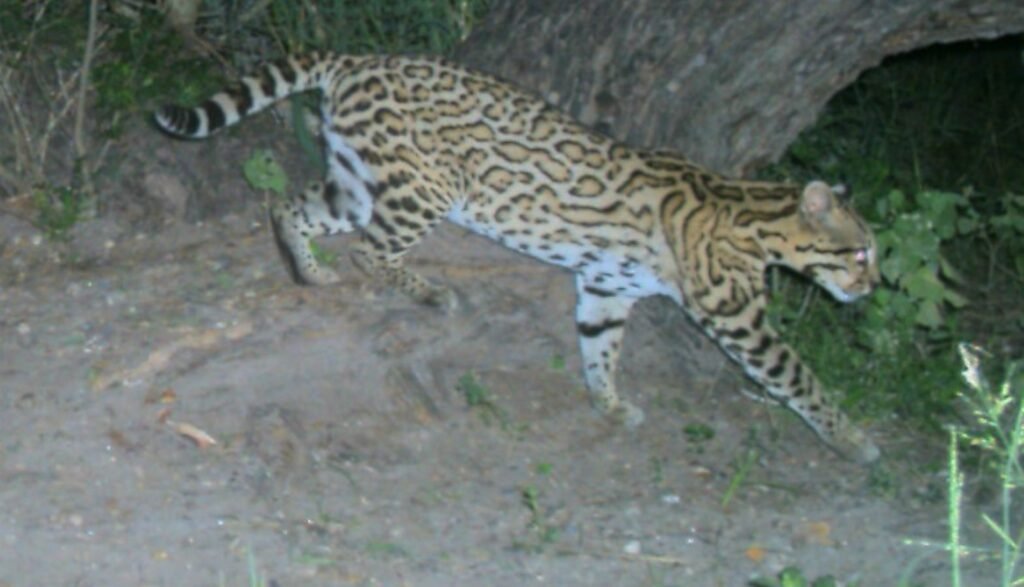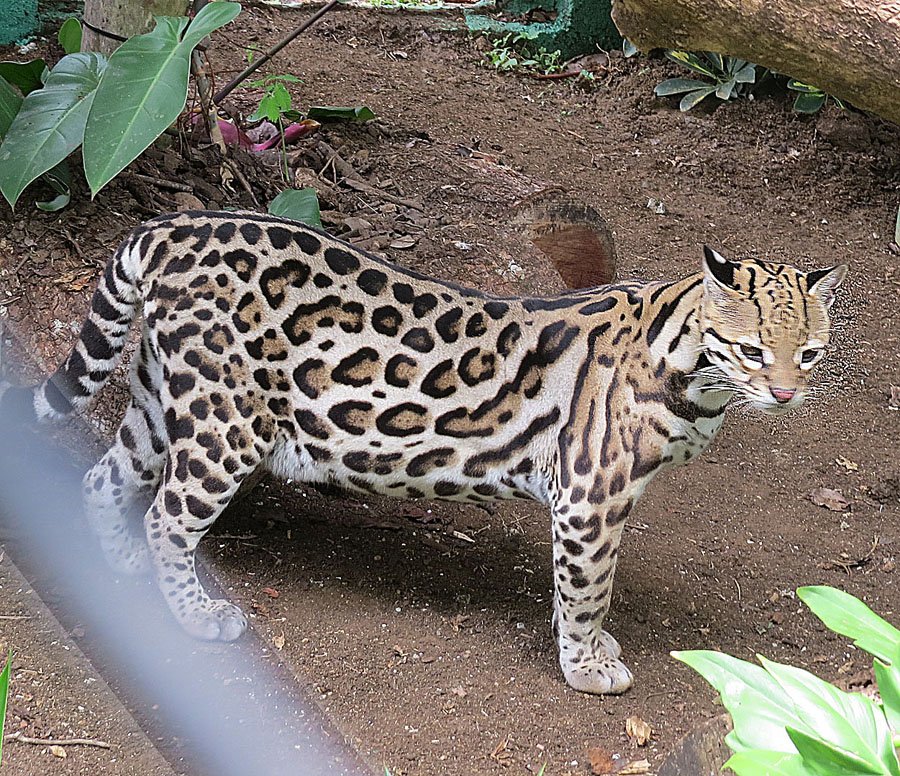Deep in the thorny brushlands of South Texas, a shadowy figure prowls through dense vegetation at dawn. With golden eyes scanning for prey and distinctive spotted coat shimmering in dappled sunlight, this is one of America’s last wild ocelots. Yet this magnificent cat faces an uncertain future, teetering on the edge of extinction in the United States.
These beautiful wildcats once roamed freely across the American Southwest, from Texas to Arkansas and Louisiana. Today, their story has become one of dramatic decline and desperate hope. With habitat destruction, vehicle strikes, and genetic isolation threatening their survival, represent both a conservation crisis and an inspiring tale of human determination to save a species from vanishing forever.
A Critically Small Population Clinging to Survival

By official counts, there are only about 50-80 of these creatures remaining in their native South Texas, concentrated in Cameron and Willacy counties. Some estimates suggest fewer than 80 ocelots remain in two tiny populations in southeast Texas, making this one of the most endangered wild cat populations in North America.
The larger population is centered on the privately owned El Sauz Ranch, with a smaller population in the Laguna Atascosa National Wildlife Refuge. These two groups represent the last strongholds for ocelots in the United States, desperately trying to maintain their genetic diversity in increasingly fragmented landscapes. Ocelots have suffered heavy mortality around Laguna Atascosa due to road collisions, and the two populations no longer exchange individuals.
The Devastating Impact of Habitat Loss

Since the 1920s, 95 percent of Texas thornscrub forest coverage in this area has been cleared for agriculture and development. This thornscrub habitat, scientifically known as Tamaulipan thornscrub, is essential for ocelot survival. These “dots” are fragments of habitat – primarily thick, dense thornscrub forest that the ocelot uses to feed, breed and move. These habitats are often disconnected, forcing ocelots to navigate roads and open areas.
Most of what remains is in fence rows, highway rights-of-way and canals. Sprawling development and other competition for land continue to limit available breeding habitat and connecting corridors that allow safe passage. The dense vegetation provides perfect camouflage for hunting and protection from predators, making habitat connectivity crucial for the species’ long-term survival.
Roads: A Deadly Trap for Ocelots

Forty percent of the population’s mortality is attributable to vehicular deaths. This shocking statistic reveals one of the most immediate threats facing Texas ocelots. Roads present a particular hazard, as car strikes are the leading known cause of death of ocelots in Texas.
They are very active, traveling from one to five miles per night. Males usually travel farther than females, especially to look for mates. This natural behavior puts them directly in the path of speeding vehicles as they cross highways in search of territory, mates, or new hunting grounds. The roadway that often splits habitat in two has frequently become the ocelot’s last destination. First hunted to near extinction and then deprived of its habitat, our final ocelot population is now being reduced to road kill.
The Genetic Bottleneck Crisis

Due to their low numbers and isolation from other ocelot populations in Mexico, ocelots in the U.S. are threatened by low genetic diversity. This leaves them vulnerable to the negative impacts of genetic defects, which may be caused by inbreeding, and diseases. The isolation of the two Texas populations has created a dangerous genetic bottleneck that threatens their long-term viability.
This lack of gene flow has dire implications: Both populations appear to be becoming inbred. Scientists worry that without intervention, the remaining ocelots may not have sufficient genetic diversity to maintain healthy breeding populations. The nearest Mexican populations are at least 100 miles from the current Texas populations, far south of the border.
Industrial Development Threatens Critical Habitat

Modern industrial projects pose new challenges to ocelot conservation. They also face significant disturbance and destruction of their habitat from industrial development like the SpaceX experimental launch site at Boca Chica and liquid natural gas export facilities along the Gulf Coast. These large-scale developments fragment remaining habitat and create additional barriers to movement.
The LRGV faces every contemporary conservation challenge of the 21st century, but ongoing human population growth and its associated demands, international border issues, and oil, gas, and alternative energy development dominate impacts that affect conservation in the LRGV. The pressure from multiple development fronts makes habitat protection increasingly challenging.
A Revolutionary Breeding Facility Takes Shape

Hope for Texas ocelots comes in the form of groundbreaking conservation technology. The Caesar Kleberg Wildlife Research Institute (CKWRI) at Texas A&M University-Kingsville broke ground on an Ocelot Conservation Facility. The facility will reportedly be a state-of-the-art complex that offers nearly 30,000 square feet of dedicated space for ocelots.
The facility will be the first in the nation dedicated to housing ocelots for breeding purposes, while providing medical and reproductive care, and an environment for young ocelots to learn hunting skills and other natural behaviors that will prepare them for release into new habitats for ocelot restoration. Construction plans are underway for this facility.
Innovative Breeding Strategies Using Texas Genetics

The breeding program employs sophisticated genetic techniques to maintain Texas ocelot heritage while increasing genetic diversity. The idea is to propagate individuals using semen from wild males so that they are South Texan genetically. And at the second generation, they’re now 75% South Texan, at which point those individuals would be released into that third population.
The key thing is that we will be using semen from wild males. So we’re keeping that Texan genetic stock. But for the females we’ll be using zoo females, which of course have broad genetic diversity and perhaps sourcing individuals from Mexico as well, which we know has higher genetic diversity than currently in South Texas. This approach avoids removing any wild Texas ocelots from their natural habitat while still maintaining genetic authenticity.
Private Ranches as Conservation Partners

This land is crucial to conservation efforts because 95 percent of the state is privately owned land, with many of the region’s ranches dating back to Spanish land grants. Without private lands, there would not be a lot of outlooks for ocelots in Texas. Private landowners have become essential partners in ocelot conservation efforts.
The USFWS approved a Programmatic Safe Harbor Agreement with the East Foundation, a Texas nonprofit and landowner that promotes the advancement of land stewardship through ranching. The agreement ensures that, if private ranchers in certain South Texas counties allow reintroduced ocelots to use their properties as habitat, the USFWS won’t require the landowners to alter the management of these ranching operations. This innovative approach removes legal barriers that might discourage landowner participation.
Massive Habitat Restoration Efforts Transform the Landscape

Community-driven restoration projects are rebuilding ocelot habitat across the Lower Rio Grande Valley. Volunteers regularly join Defenders of Wildlife, American Forests, U.S. Fish and Wildlife Service and Friends of the Wildlife Corridor to plant thousands of seedlings across retired farmland in community restoration events.
According to the plan, the reforestation potential in the Rio Grande Valley is immense; up to 81,000 acres, with approximately 25,000 acres already under the management of the FWS. With projections estimating a need for over 12 million trees, even at conservative planting densities (such as 500 trees per acre), the Rio Reforestation initiative is just one part of a much larger effort to restore this ecosystem. These restoration efforts create the connected corridors that ocelots need to move safely across the landscape.
Wildlife Corridors: Creating Safe Passage Networks

American Forests and the USFWS are targeting Texas thornscrub restoration work in three wildlife corridors in the Lower Rio Grande Valley. These corridors serve as green highways that allow ocelots to travel between habitat patches without crossing dangerous open areas or roads.
The U.S. Fish and Wildlife Service, Texas Parks and Wildlife Department, The Nature Conservancy, and many local landowners have been working to protect, acquire and restore Ocelot habitat in the Rio Grande Valley. Restoration generally involves revegetating previously cleared areas with native trees and shrubs. The U.S. Fish and Wildlife Service and the Texas Department of Transportation are also working together to try and reduce Ocelot road mortality by installing Ocelot underpasses under roads where Ocelots are known to frequently cross.
The Challenge of International Connectivity

Distance, development and the border wall all make connectivity between U.S. and Mexican ocelots difficult – especially in the Lower Rio Grande Valley. The new release site represents the best possibility for connectivity, but continued border wall development could threaten movement of ocelots and other recolonizing species. Border infrastructure creates additional barriers to natural wildlife movement.
Despite USFWS spending more than 45 years and about $82 million to acquire 105,000 acres of refuge land in the Lower Rio Grande Valley, none of these preserves are likely to host ocelot movement in the future. That’s because sprawling McAllen and Brownsville are among the fastest-growing cities in Texas, and they, along with cities on the Mexican side of the river, prevent Texas ocelots from dispersing into or through these refuges.
Community Education and Awareness Programs

The Ocelot Conservation Festival brings the community together at the Gladys Porter Zoo, in Brownsville, Texas, each spring. Attendees learn about ocelots and how they can help save them. Educational outreach helps build public support for conservation efforts and encourages safe driving practices in ocelot habitat.
Defenders works on many projects connected to ocelot recovery including participating in programs to restore and connect ocelot habitat, advocating for road crossings to help ensure safe passage for the cats, challenging development and disruption within habitat corridors, and supporting on the ground research. Defenders works on the ground to assess community perceptions of ocelots, raise awareness of these cats on the landscape and share best practices for coexisting with them.
A Race Against Time

It’s still possible to reverse the trend and start it back toward recovery, but we better do something quick. If we stick with the status quo, we are going to lose the ocelot in this country. The urgency of the situation cannot be overstated, as every year of delay increases the risk of losing this iconic species forever.
The population, currently estimated at 50-80 individuals, will need to significantly increase to reach the goal of removing it from the endangered species list. This ambitious target requires sustained effort across multiple conservation strategies, from habitat restoration to breeding programs to community engagement. Because ocelots in Texas all live in low-elevation coastal areas, some worry that the viability of the entire existing U.S. breeding ocelot populations and their habitat could be lost in a single local catastrophic event, such as a high-impact tropical storm along the Gulf coast.
Conclusion

Texas ocelots stand at a critical crossroads between extinction and recovery. Their story embodies both the devastating consequences of habitat destruction and the remarkable power of human determination to right past wrongs. Through innovative breeding programs, massive habitat restoration efforts, and unprecedented collaboration between government agencies, private landowners, and conservation organizations, there is genuine hope for these magnificent cats.
The success of ocelot conservation in Texas will depend on maintaining momentum across multiple fronts: completing the revolutionary breeding facility, expanding wildlife corridors, reducing vehicle mortality, and fostering community support. Every restored acre of thornscrub, every wildlife underpass, and every person who drives more carefully through ocelot habitat contributes to their survival. What do you think will be the most crucial factor in determining whether Texas ocelots survive or disappear forever?

Hi, I’m Andrew, and I come from India. Experienced content specialist with a passion for writing. My forte includes health and wellness, Travel, Animals, and Nature. A nature nomad, I am obsessed with mountains and love high-altitude trekking. I have been on several Himalayan treks in India including the Everest Base Camp in Nepal, a profound experience.




